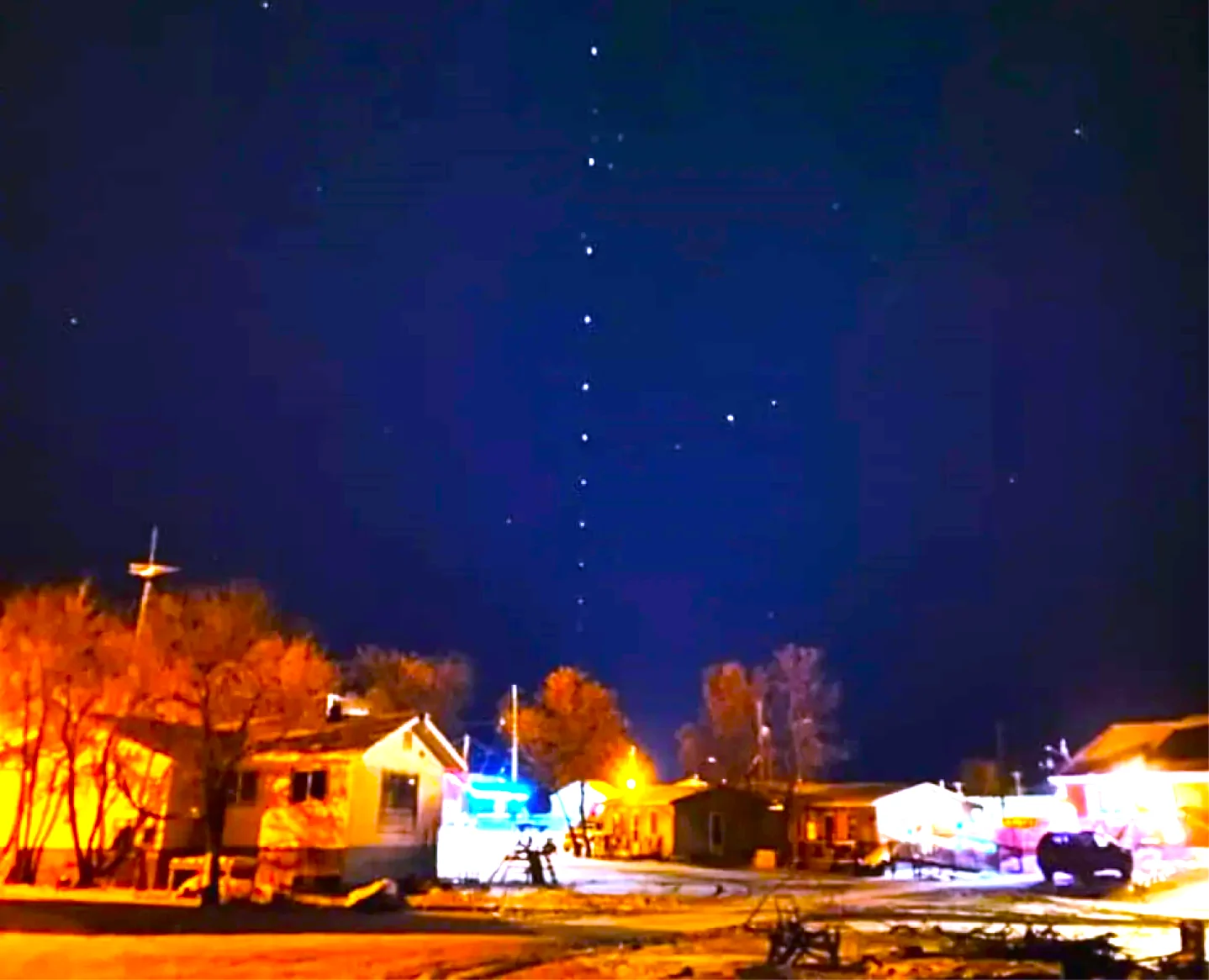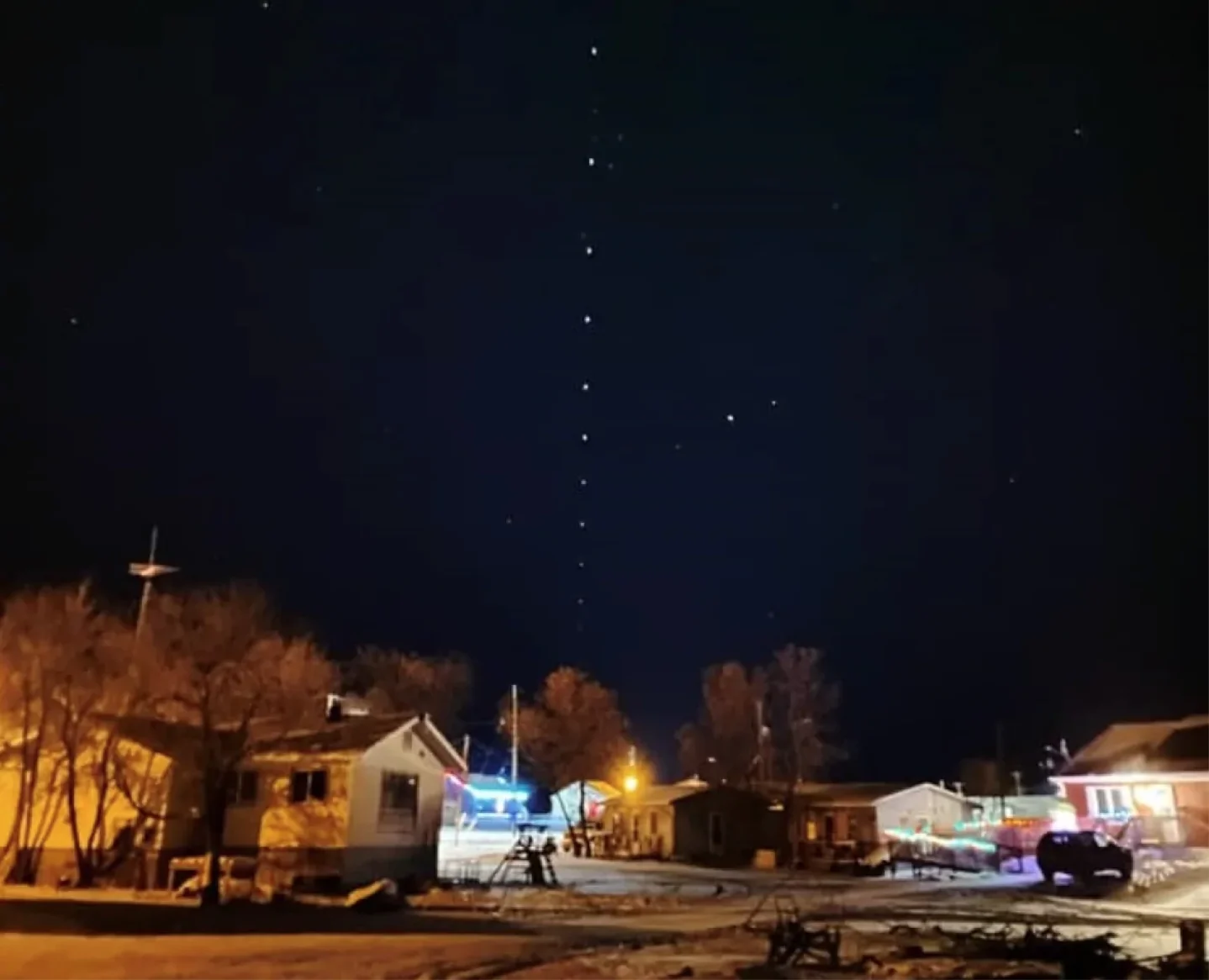
Strange string of lights in Manitoba spark confusion, intrigue

(Image: Shannon Letendre snapped a photo of a row of lights spotted from central Manitoba's Interlake region on Friday. Submitted by Shannon Letendre/Facebook via CBC News)
Evelyne Bosc was out for a walk when she saw them.
"They were all perfectly aligned, and perfectly spaced from one to the other," she said. "It was very odd."
Bosc said she was passing the cemetery near her St. Claude, Man. home around 6:30 p.m. Thursday when she looked west and saw a line of 14 lights slowly passing over her in the sky.
The lights were only visible for about two minutes before they disappeared, Bosc said.
"It was kind of a bit scary, because it's something I've never seen. But then I was kind of in awe of what I was witnessing," she said. "I just thought at first it was like a constellation [of stars]… Then I realized it was certainly not that, that it had to be something more unusual."
Shannon Letendre posted to Facebook about the bizarre row of lights she saw slowly move upwards before disappearing into the clear night sky above Dauphin River 48A, a community located about 256 kilometres north of St. Claude.
Scott Young, who manages the planetarium and science gallery at the Manitoba Museum, said the strange lights dotting the sky — which have also been reported near La Rivière, Man. and Eriksdale, Man. — can likely be attributed to the Starlink constellation of satellites.
"Usually they're pretty faint, they're pretty hard to see, but it turns out that starting on Boxing Day we just happened to have circumstances aligned so that they were coming right over Winnipeg just as the sun is setting," he said.
Young said because the satellites were all launched on the same path, they will stay clustered together for several days, which is why they're appearing as lines of dots in the sky.
"So the sky is dark, but up at orbital height it's still bright, and so the sunlight from the sun is shining off of these satellites and making them bright enough to see with the unaided eye," he said.
'LIKE THE WILD WEST'
The Starlink constellation is a project by aerospace company SpaceX, which will eventually launch 12,000 satellites into space to provide improved internet access across the world.
"It's basically the spread of telecommunications. Originally, it was radio waves, and then phone lines and now satellites," Young said.
"Whenever I see a satellite, I'm amazed that we live on a planet that we can actually make things that can go to the stars. That's pretty impressive … It's really sort of a reminder that humanity can do really amazing, sometimes impossible, things. All we have to do is put our mind to it."
But Young said there can be problems that come with having more satellites floating around in space. Astronomers who rely on long-exposure photography for their work are having their frames cluttered up with streaks of light from the satellites, he said.
Having more pieces of equipment in orbit also increases the risk of the satellites colliding and being destroyed, or putting human spaceflight at risk.
"Space is big, but it's not infinite, and it's already starting to get fairly crowded up there in orbit," he said.
"It's kind of like the Wild West up there, where if you've got the money you can pretty much launch stuff into space and nobody's going to stop you."
Young said there isn't any evidence to suggest anything bad will come from the satellites, which is partially because it's still too early to know the long-term effects.
"The problem is nobody's telling these companies to do anything about it, so they're not going to do long-term studies because it's not really germane to their interests," he said. "There's no real regulation."
Young said the satellites will likely be visible in the Manitoba sky between 5:30 and 6 p.m. for the next week or so.
FROM THE ARCHIVE: RARE BUT REALLY COOL LIGHT PILLARS SPOTTED IN MANITOBA
--
Editor's note: Thumbnail image was brightened up for better visibility. This article was originally published for CBC News.





